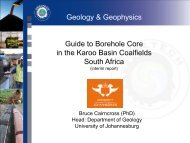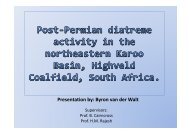coaltech upper olifants river catchment wetland inventory ...
coaltech upper olifants river catchment wetland inventory ...
coaltech upper olifants river catchment wetland inventory ...
You also want an ePaper? Increase the reach of your titles
YUMPU automatically turns print PDFs into web optimized ePapers that Google loves.
3.5.1.2 Groundwater recharge<br />
Various <strong>wetland</strong> types, including floodplain and riparian <strong>wetland</strong>s may contribute to<br />
groundwater recharge. Pans may also contribute to groundwater recharge. This outward<br />
seepage from the pans may help to regulate the build-up of dissolved solids in the system.<br />
Seeps are responsible for groundwater discharge and almost never contribute to<br />
groundwater recharge (Palmer et al 2002, Allan et al 1995, Kotze 2000, Kotze et al 2000).<br />
3.5.2 Water purification<br />
3.5.2.1 Nitrogen removal<br />
It is difficult to determine the amount of nitrogen removal by a <strong>wetland</strong> without measuring the<br />
input and output nitrogen. The transformation processes, such as denitrification, requires<br />
specific conditions in order to proceed. The reaction rate of this process is a function of the<br />
reactant concentration and the applicable bacteria. These processes are therefore more<br />
likely to take place in <strong>wetland</strong>s and <strong>wetland</strong> areas with more organic material (Palmer et al<br />
2002, Kotze 2000, Kotze et al 2000).<br />
The three transformation processes of nitrogen are plant uptake, nitrification and<br />
denitrification (Palmer et al 2002). The specific processes and rate of the process depends<br />
on the specific characteristics of the <strong>wetland</strong>. It should be taken into account that all three of<br />
the processes may take place in the same <strong>wetland</strong> (Palmer et al 2002, Kotze 2000, Kotze et<br />
al 2000, Brady & Weil 1999).<br />
3.5.2.2 Phosphate removal<br />
Phosphates enter a <strong>wetland</strong> from various sources, both natural and anthropogenic.<br />
Phosphate removal is not a microbial process, but a physiochemical process. As with<br />
nitrogen removal the amount of phosphate removed cannot be determined without<br />
measuring the input and output phosphate. Unlike nitrogen removal, however, the removal of<br />
phosphates is not dependant on the presence of bacteria. The removal of phosphates takes<br />
place via precipitation, absorption onto clay particles or uptake by plants. These phosphates<br />
can therefore be released into the environment by a change in the micro-environment or by<br />
the natural die-back of plants (Palmer et al 2002, Kotze 2000, Kotze et al 2000).<br />
Wetland Database for UORC - 35 -




